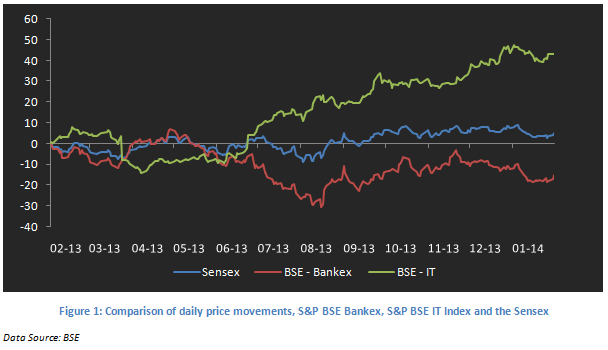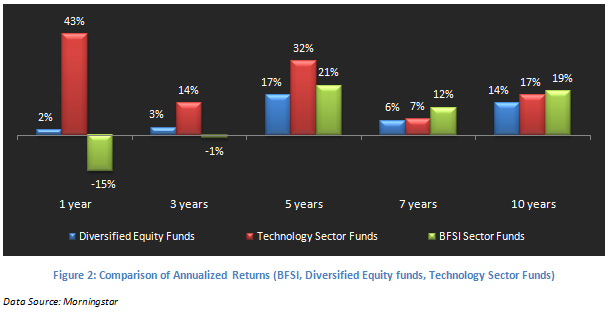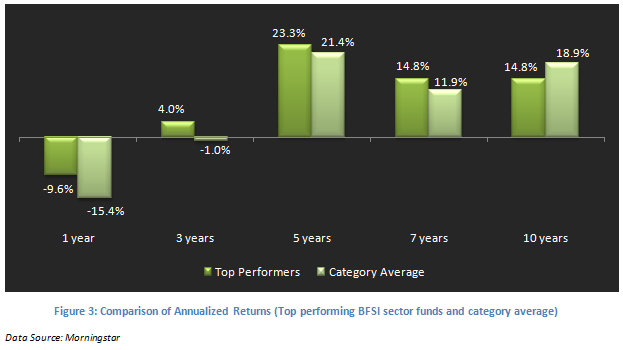Review of Banking and Financial Services Sector Mutual Funds

In the last 2 articles in this series we had discussed that IT and Healthcare sector funds had outperformed the market over the last one to two year periods. In this article, we turn our attention to Banking, Financial Services (BFSI) sector. This sector has the highest weightage in both Sensex and Nifty. The performance of this sector is closely correlated with the overall economic growth in the country. BFSI as a sector has underperformed with respect to the broader market over the last one year period. The chart below shows the daily price movements of the S&P BSE Bankex (the Index for BFSI stocks), S&P BSE IT Index and the Sensex, indexing prices of all the three indices on Feb 19 2013 to zero.

The red line graph clearly shows that BFSI as a sector has lagged behind the market (in blue line). The returns, in fact, have been negative at -14.8% while the Sensex has delivered about 5.5%. Similarly the Bank Nifty, which the NSE counterpart of the Bankex, has delivered -14.4%. The reason for the weak performance of this sector is well known. With economic slowdown the demand for credit has remained subdued. High inflation and interest rates have hurt the sector. The asset quality has worsened in this period, with increase in NPAs and write offs. The short term outlook is mixed
- With general elections around the corner, business sentiments and reforms program will pick up if we get a stable government
- It will take a longer time for investment cycle to revive. Therefore, demand for corporate credit may remain sluggish in the short term
- Though there are signs of inflation cooling off, the inflation level is still high and the lowering of interest rates will be gradual
- Asset quality will continue to be a concern
However, from a long term viewpoint this sector presents attractive opportunities. Many experts believe that equity markets are bottoming out, even though the market may further go down by a few percentage points in the short term. It goes without saying that, the BFSI sector will lead the return to long term bull market. From a fundamental perspective, some private and public sector banks are trading at attractive valuations. There are also structural changes taking place in this sector. A set of new banks will get banking licenses from the RBI later this year. New norms of NPA recognition once implemented, will lead to improvement in asset quality in the future. As a result of these changes the health of the BFSI sector will surely improve.
Should mutual fund investors consider BFSI Sector Funds
As discussed earlier in this series, for our long term financial objectives, diversification is the best strategy, and therefore for long term goals like retirement planning and children’s education, one should always choose diversified equity funds through a systematic investment plan. Changes in central government and RBI policies, as well industry specific issues of the debtors, may impact the BFSI sector, either in a positive or a negative way. This sector is also a high beta sector, which means that the volatility in this sector is very high. As such investors with a short term horizon should stay away from this sector. However, for well informed active investors, BFSI funds can be good investment opportunities in the medium term, due to the reasons mentioned above. The chart below shows the comparison of annualized BFSI average category returns over one, three, five, seven and ten years time horizons, with diversified equity and technology sector categories

While the BFSI has clearly underperformed in comparison to the diversified equity and technology in the short term, it has outperformed in the seven to ten years time horizon. As discussed earlier in this series, over a very long term period the performance of sector funds levels out versus diversified equity funds. It is important for investors in BFSI funds to time their entry and exit correctly, so that they can capture superior returns.
Top Performing BFSI Sector Funds
As with selection of any mutual fund scheme, fund manager track record is very important. Though there are not a lot of scheme to choose from in the BFSI sector mutual funds, the performance has been consistent across funds in this sector. The chart below shows the differences in the investment returns generated by the top performers in the BFSI Sector Funds category and the category in general over one, three, five, seven and ten years time periods.

The table below lists the top 5 performing BFSI sector funds (growth options) from established Asset Management Companies, based on five year annualized returns

ICICI Prudential Banking and Financial Services Retail Fund:
This is the best performing scheme in the BFSI sector with 5 year annualized return of over 23% returns. This scheme was launched in 2008. The fund manager has a large cap bias with a high growth focus. It is reasonably well diversified across the sector, with its top 5 holding, HDFC Bank, ICICI Bank, SBI, Bank of Baroda and Max India accounting for little over 56% of the portfolio value. The fund has garnered Rs 2.3B assets under management and an expense ratio of 2.43%.
Reliance Banking Fund:
This is one of the oldest funds in this sector. It was launched in 2003. The fund has the lowest expense ratio in this category at only 1.93%, because of its substantial assets under management (Rs 13.4B). The scheme has predominantly a large cap focus, and is well diversified in the BFSI sector. HDFC Bank, ICICI Bank, SBI, J&K Bank, Bajaj Finance and Indiabulls Housing Finance account for 54% of the portfolio holdings.
Religare Invesco Banking Fund:
This fund was launched in 2008 and has garnered Rs 540 million assets under management. The expense ratio of the fund is 2.5%. The fund has a large cap bias. The top 5 holdings, HDFC Bank, ICICI Bank, Federal Bank, HDFC and Kotak Mahindra Bank account for little over 66% of the portfolio value.
UTI Banking Sector Fund:
This fund has a large cap bias with ICICI Bank, HDFC Bank, Axis Bank, SBI and IndusInd Bank accounting for 80% of the portfolio value. This scheme has nearly completed 10 years and has Rs 2.9B assets under management, with an expense ratio of 2.62%.
Sundaram Financial Services Opportunities Fund:
This fund has a large cap bias, and is fairly well diversified within the BFSI Sector, HDFC Bank, ICICI Bank, SBI, Bajaj Finance and DCB Bank accounting for 58% of the portfolio value. The scheme, launched in 2008, has Rs 1.2B assets under management, with an expense ratio of 2.41%.
Queries
-
What is the benefit of mutual fund STP
Aug 29, 2019
-
How much to invest to meet target amount of Rs 2 Crores
Aug 26, 2019
-
Can I achieve my financial goals with my current mutual fund investments
Aug 24, 2019
-
Can you tell me return of various indices
Aug 19, 2019
-
What would be the post tax return on different investments
Aug 18, 2019
-
Which Principal Mutual Fund scheme will be suitable for my retirement corpus
Aug 16, 2019
-
What is the minimum holding period for availing NCD interest
Aug 4, 2019
Top Performing Mutual Funds
Recommended Reading
Fund News
-
Bandhan Mutual Fund launches Bandhan Silver ETF FOF
Jan 12, 2026 by Advisorkhoj Team
-
Bandhan Mutual Fund launches Bandhan Gold ETF FOF
Jan 12, 2026 by Advisorkhoj Team
-
The Wealth Company Mutual Fund launches The Wealth Company Gold ETF FOF
Jan 9, 2026 by Advisorkhoj Team
-
Mahindra Manulife Mutual Fund launches Mahindra Manulife Innovation Opportunities Fund
Jan 9, 2026 by Advisorkhoj Team
-
Jio BlackRock Mutual Fund launches Jio BlackRock Short Duration Fund
Jan 8, 2026 by Advisorkhoj Team














